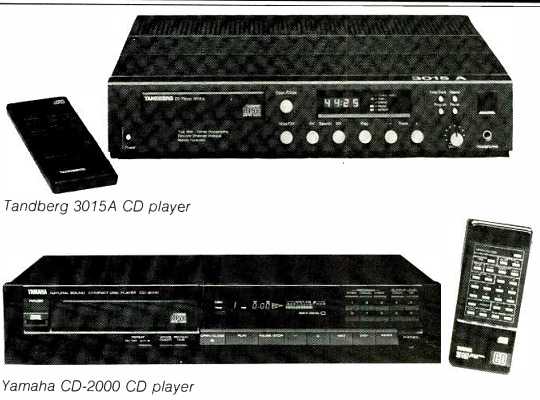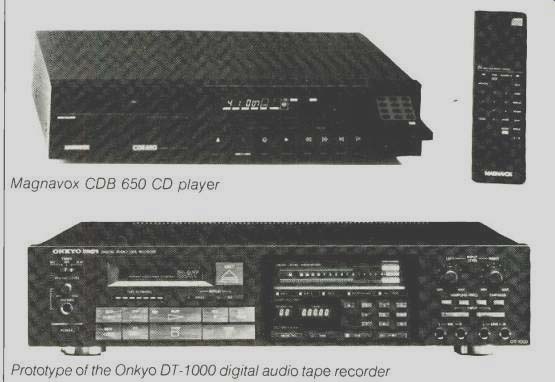MARKING TIME

If the 104,163 industry people who attended the 1986 Winter CES in Las Vegas were expecting any major advances in technology or the introduction of exciting new product categories, they were sorely disappointed.
The general consensus seemed to be that most manufacturers were marking time, merely showing updated and face-lifted versions of existing products. It was apparent that they had decided to make their major new product introductions at the Chicago Summer CES.
At both the summer and winter shows, I spend most of my time where the high-end components are demonstrated. At this WCES, high-end audio components were shown at the Sahara Hotel, and I must say I felt very sorry for the manufacturers who had to exhibit there. These companies spent a lot of time and money trying to present worthwhile demonstrations of their products, but even the most conscientious of them could not cope with the Sahara's abominable exhibit rooms.
Not only were they relatively small, converted guest rooms, but their raised platforms upon which beds are normally placed could not be re moved. The sounds from loudspeakers made many of these large, undamped platforms vibrate and resonate, super imposing a most degrading coloration on the reproduced sound. This made any accurate assessment of quality well nigh impossible. Surely, audio components deserve better than this sort of treatment.
As is usual these days at Consumer Electronics Shows, CD players held the spotlight. Though virtually every major component manufacturer offers CD players for home use (most made by several OEM suppliers), new con figurations continue to proliferate.
There is a trend towards changer-type CD players. For the car, Sony has their unique "Disc-Jockey," with a 10-disc changer remotely mounted in the car trunk. CD changers for the home are represented by such units as the original six-disc Pioneer PD-M6 and a five-disc Mitsubishi model. One of the problems with the various CD changers, for home or car, is that they all use different magazines or disc caddies for holding discs such that none of them are compatible with each other. (See the feature article on CD changers in this issue. -Ed.) Many of the mid-priced and high-end CD players are much improved.
Some incorporate third-generation technology which affords remarkably high-quality reproduction. More CD players are being designed with extra refinements and convenience features in an effort to make them seem different and more desirable.
Onkyo was showing what was billed as the first CD player to use fiber-op tics technology. Six fiber-optic cables interconnect various stages carrying only digital information such as LJR, word and bit clock signals, audio data, de-emphasis actuate, etc. All this is supposed to help achieve lower noise and distortion. A U.S. version, the DX-320, should be available this spring.
Tandberg introduced the TCP 3015A Compact Disc player. This $1,295 unit apparently will be one of the first to employ the new Philips 16-bit, four-times oversampling, 176.4-kHz system. Dual D/A converters are used, along with digital and analog filtering. The analog circuitry is direct coupled, is totally discrete (no ICs)., and has zero negative feedback. Wire less remote control is provided, along with a full complement of time-display and programming features.
Yamaha introduced no less than 10 new CD players, ranging in price from $249 to just under $1,000. The CD 2000 and CD-2000M are the flagship models, with the latter featuring XLR balanced-line inputs and special r.f. shielding for broadcast and studio use.
Both units use Yamaha's third-generation digital filter (which has a 90-dB cutoff slope); new fifth-order active analog filters are also used. An important feature is a new vibration-damping assembly for the analog audio circuit board. Newly designed VLSI chips are used, 88.2-kHz oversampling is employed, and an S/N ratio of 105 dB is claimed.
The Magnavox CDB 650 uses Phil ips' new 16-bit/176.4-kHz oversampling system, has a new laser pickup, and features access time of less than 1 S. Uniquely, 785 tracks from different CDs can be programmed into the unit! The price is $410.

---Tandberg 3015A CD player
---Yamaha CD-2000 CD player
Much to the horror and chagrin of the anti-digital brigade, there are people (many of whom are newly minted audio enthusiasts) who don't care one whit about vinyl phonograph records and don't even own a turntable! For these people, and for those who want a really high-quality preamplifier for CD playback, the clever folks at Mod Squad have introduced their Active Line Drive. This neat, compact unit has an outboard power-supply transformer and has high-level inputs for CD, tuner and video equipment, plus two auxiliary inputs. A tape-monitor loop is provided. Front-panel rotary controls include an input selector, balance control, 31-step volume control, and a source/mute/tape switch. According to Mod Squad specs, the Active Line Drive provides 18 dB of gain, with an S/N ratio of 90 dB and very low harmonic and IM distortion. The output impedance is 100 ohms, maximum output is 13.5 V rms, and the unit will safely drive virtually any power amp.
At $500, the Active Line Drive is a good companion for upscale CD players. I have used this unit with a number of high-quality amplifiers, and it has proven to be an excellent performer. Its sound is very neutral and clean, with an open, transparent quality, a nice preservation of depth, and good, stable imaging. The unit is extremely quiet and does not degrade the S/N ratio of even the most expensive CD player. Eliminating the cost of high-quality phono circuitry enabled the Mod Squad to provide the Active Line Drive with high-quality parts and to achieve a level of performance as good as many higher priced preamps.
Although a number of Japanese manufacturers are known to have fully developed models of digital audio tape recorders, they have been keeping them under wraps, apparently by mutual agreement. However, Onkyo evidently believed the CD market was so strong that there was really no compel ling reason for further delay. Thus, they showed a prototype of their DT-1000 DAT recorder, although price and de livery schedule were not announced. The DT-1000 is equipped with a real time music counter and music program system, allowing access to any part of a program by index or time.
As you may know, the Japanese have developed both stationary-head and rotary-head DAT system versions. To make matters more complicated, he EIAJ (Electronic Industries Association of Japan) has adopted both for mats as standards.

-------Magnavox CDB 650 CD player; Prototype of the Onkyo DT-1000 digital
audio tape recorder
However, there seems to be a general favoring of the rotary-head R-DAT format, and this is what Onkyo has employed in the DT-1000. The R DAT cassette is approximately two-thirds the size of a standard audio cassette. It moves at a snail's pace of 8.15 or 12.225 mm per second, which respectively affords 120 and 80 minutes of recording. There are two channels, and with a 30-mm recording drum operating at 2,000 rpm, the writing speed of 3.13 meters per second is equivalent to a linear speed of over 10 feet per second! Quantization is 16-bit linear, and the sampling rates are 48, 44.1 and 32 kHz. You may note that the 48-kHz rate is the same as used in the professional digital formats; theoretically, this means that a DAT cassette might exhibit higher resolution than a CD! Error correction is similar to CD, with double-encoded Reed-Solomon code employed.
A remarkable system, this DAT. One can only speculate on its uses. Of course, to be competitive with CD there will have to be prerecorded DAT music cassettes. Even when duplication becomes fast and cost-effective, however, a comparison of wear characteristics would still favor the CD.
Though many playbacks could be made with little degradation, eventually there would be wear on the magnetic coating of the tape (even with evaporated metal), and edge-frilling of the tape could also be, ultimately, a de grading and limiting factor. Nonetheless, the DAT provides fascinating new recording technology.
(adapted from Audio magazine, Jul. 1986; Bert Whyte)
= = = =